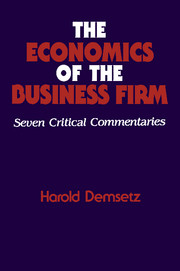Book contents
- Frontmatter
- Contents
- Preface
- First commentary: The firm of theory: its definition and existence
- Second commentary: Agency and nonagency explanations of the firm's organization
- Third commentary: Enterprise control, wealth, and economic development
- Fourth commentary: Profit maximization and rational behavior
- Fifth commentary: The use and abuse of accounting profit data
- Sixth commentary: Management compensation and tournament theory
- Seventh commentary: The intensity and dimensionality of competition
- References
- Index
Seventh commentary: The intensity and dimensionality of competition
Published online by Cambridge University Press: 06 July 2010
- Frontmatter
- Contents
- Preface
- First commentary: The firm of theory: its definition and existence
- Second commentary: Agency and nonagency explanations of the firm's organization
- Third commentary: Enterprise control, wealth, and economic development
- Fourth commentary: Profit maximization and rational behavior
- Fifth commentary: The use and abuse of accounting profit data
- Sixth commentary: Management compensation and tournament theory
- Seventh commentary: The intensity and dimensionality of competition
- References
- Index
Summary
Economists are so familiar with the perfect competition model that they tend to confuse this with competition more broadly conceived, but our understanding of competition is seriously deficient once we leave the safe harbors of the perfect competition, monopoly, and Cournot oligopoly models. The main task of this commentary is to convince the reader of this. A subsidiary task is to give a summary evaluation of the antitrust experiment in the United States.
The problem of competitive intensity
Intuition clings to a notion of competing that is something like “effort expended to best the performance of others.” Performance might refer to prices, qualities, technical progress, or any of an infinitely long list of activities in which persons engage. As we shall see in the next section, this variety of competitive activities is a source of much difficulty both for the theory of competition and for public policy toward competition, but we may begin our discussion by focusing more narrowly on price competition.
Is there price competition? Are prices set competitively? These are the questions most frequently asked in regard to the competitiveness of markets. This emphasis on price competition clearly owes its origin to our interest in the price system as an allocator of resources and to the formalization of this system through the perfect competition model. However, perfect competition, the central model of neoclassical economics, does not really involve competitive pricing activity. The equilibrium market clearing price that emerges from the perfect competition model may be termed a competitive price, but it results from mysterious market clearing forces and not the competitive pricing activities of firms.
- Type
- Chapter
- Information
- The Economics of the Business FirmSeven Critical Commentaries, pp. 137 - 169Publisher: Cambridge University PressPrint publication year: 1995
- 2
- Cited by



